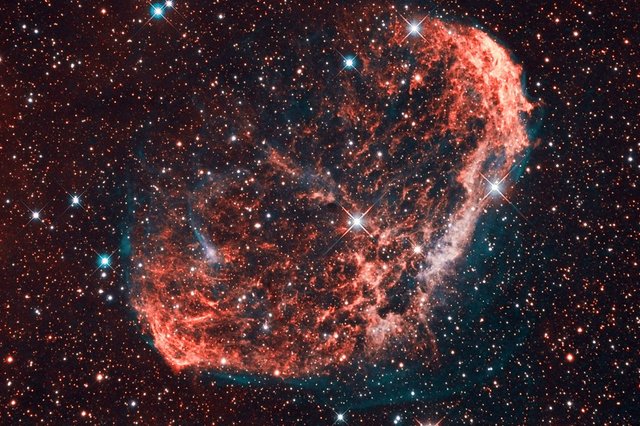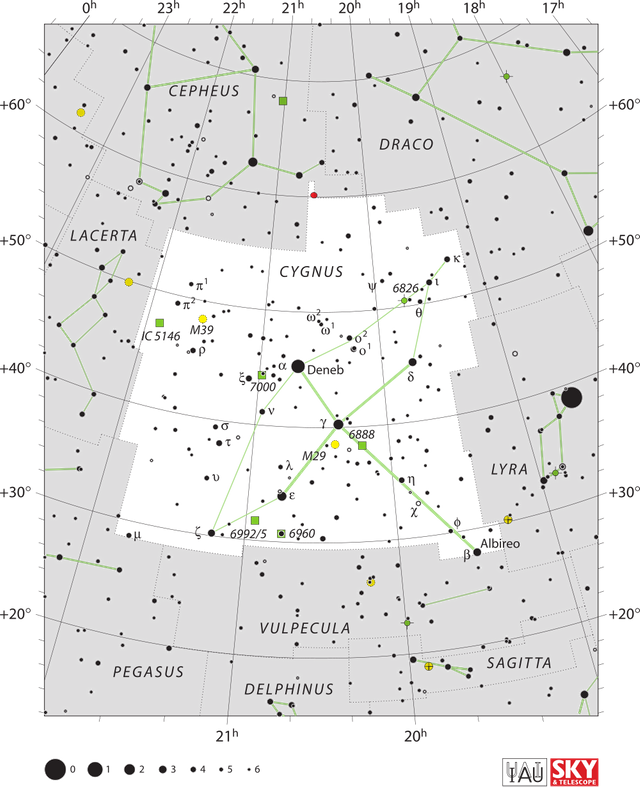Astronomical Observations #35: Crescent Nebula (NGC 6888)
Welcome to the next episode of the review most interesting objects of the night sky. I am showing you those that we can see with an amateur telescope. This time we will make a small return to nebular objects. NGC 6888 is an interesting emission nebula that is found in the constellation of Cygnus.

By Remidone link [CC BY-SA 4.0 license]
Constellation of Cygnus appears over our heads in the early summer months. Lovers of the night sky around the world can admire dozens of beautiful objects in this great and famous constellation. One of the less popular objects of the Cygnus is the Crescent Nebula (NGC 6888). The object was discovered in 1792 by William Herschel (discoverer of the planet Uranus). The Crescent Nebula lies about 4,700 light years away from our planet. The object was created thanks to a bright and hot supergiant - the star of Wolf-Rayet, which lies in the heart of this nebula. This star was created about 4.5 million years ago. However, some 250,000 years ago, the stellar supergiant passed from the phase of the red dwarf to the star Wolf-Rayet. This led to the rejection of the outer shell of the star and the formation of the nebula in the form we now see.

By IAU and Sky & Telescope magazine (Roger Sinnott & Rick Fienberg) link [CC BY 4.0 license]
Most bright nebulae need a source of energy to shine. The Crescent Nebula draws its power from the radiance of the central star. Probably the Wolf-Rayet star is now near its end and probably will explode in the near future as a supernova. It dumps the mass at a crazy pace, from the supergiant, approaching the mass of the Sun in only about 10,000 years. The Crescent Nebula is not the simplest object to see. To find it in the sky you need a telescope with a diameter of 8 inches and a very dark, clean sky far away from city lights. We are looking for the object about 2.5 degrees southwest of the Sadr star (the central star of the Cygnus constellation). The Crescent Nebula covers the sky area with dimensions 18 '× 13' (angular minutes).

(My modification) Original by Jeffjnet link [CC BY-SA 3.0 license]
If you use telescope over 12 inches in diameter to see a shape similar to photos. Of course, colors will not be seen in amateur equipment. The observed brightness of the object is about + 7.5 magnitude, so there are chances to hunt this nebula with large binoculars. The surroundings of this nebula, as well as the entire constellation of Cygnus, is a magnificent, gigantic cluster of bright stars of the Milky Way. The characteristic cross of the Cygnus constellation rises high in the eastern sky in early summer around midnight (in the northern hemisphere). Browsing this part of the sky, even with the same binoculars, shows such a huge amount of stars that even someone who has no idea about heaven will say: great! I hope that these few tips will be helpful to those of you who have the opportunity and desire to look into the night sky.
Greetings to lovers of Astronomy!
References:

This post has been voted on by the SteemSTEM curation team and voting trail in collaboration with @curie.
If you appreciate the work we are doing then consider voting both projects for witness by selecting stem.witness and curie!
For additional information please join us on the SteemSTEM discord and to get to know the rest of the community!